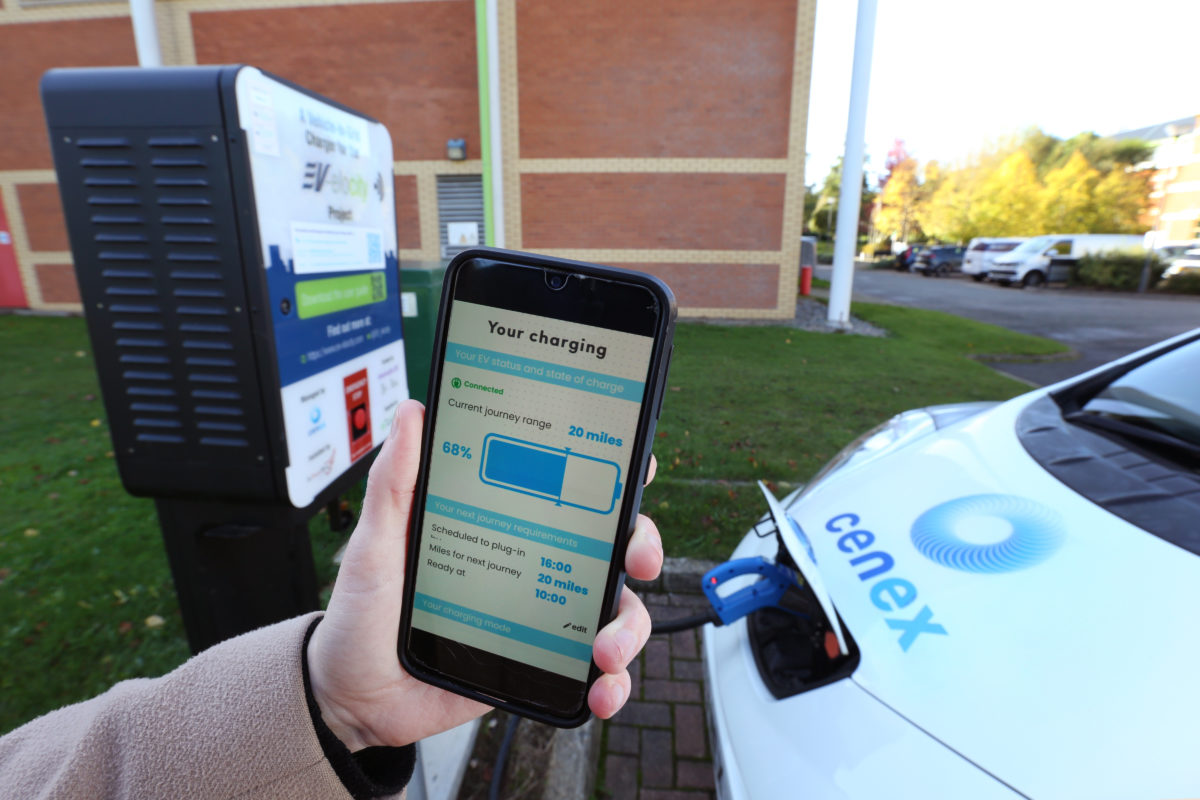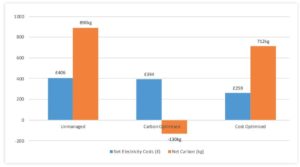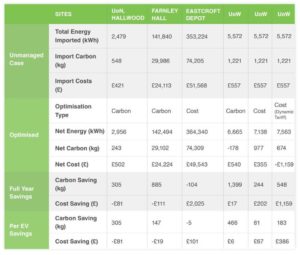
- Categories:
- News
- /
- Project Update
Costed Carbon Reduction with Vehicle-to-Grid
Optimising V2G charging cycles for carbon intensity
Many studies have looked at the financial benefits of Vehicle-to-Grid (V2G). By charging and discharging Electric Vehicles (EVs) at optimal times, value can be generated. Whether it’s preventing expensive electricity from being imported or released energy back to balance the grids, the costs and revenues of V2G are relatively well established.
The question of whether V2G can save carbon is a less extensively researched topic. At a system level, the answer appears to be yes.
But can the individual driver or fleet manager reduce their own carbon footprint by using V2G?
EV-elocity research
As part of the EV-elocity project (read the final report here) Cenex used its REVOLVE model to analyse the duty cycles of vehicles to establish whether CO2 emissions could be reduced.
The model was updated so that a site was deemed to consume carbon based on the carbon intensity of the grid at the time the electricity was consumed. Conversely, the site was credited carbon at the prevailing carbon intensity if it exported energy back to the grid.
Reducing carbon
The results show that optimising V2G cycles for carbon could reduce emissions by over 1 tonne. In fact, since this supported lower-carbon, intermittent renewable energy, the net effect was to save around 130 kg carbon (see ‘carbon optimised’, above).
The significant carbon savings result in a net negative carbon position. This means that through arbitrage, V2G units are able to save more carbon across the energy system than the associated carbon emissions of the electricity used to charge and drive the EVs.
Intriguingly, this came at a slightly reduced cost of £12 over the 38-week trial period, likely due to a weak correlation between cheaper overnight periods and lowest carbon intensity periods.
Reducing carbon when you try to save cost
When the model is run under the same conditions to optimise for cost, significant carbon savings were also achieved, even though there is no incentive to do so.
This is because the lowest cost times have lower carbon intensity on average, which produces the additional savings.
Reducing carbon and saving cost
After optimising cost and carbon separately, the next question is whether benefits can be gained by optimising both. This is to discover the price that carbon needs to be valued in order to encourage significant carbon savings.
A fixed-price for carbon was included and the model was re-run to optimise to reduce costs, both cost and carbon savings were achieved.
With a carbon price of zero, the total carbon impact of the vehicles is 712 kg. However, with a negligible price of £0.01 per tonne, the carbon impact if reduced to 405 kg without any cost implications.
Beyond that, the carbon price needs to rise above £20 per tonne before significant additional carbon savings are made. At £500 per tonne, the carbon impact is negative 69 kg, not far off the upper bound of negative 130 kg impact achieved by the pure carbon optimisation.
The result of increasing the carbon price on the unmanaged cost is a corresponding increase in cost. However, jointly optimising cost and carbon is able to mitigate almost all of the carbon price increases.
Conclusions
This analysis demonstrates that cost savings can be achieved without additional carbon emissions under a simple two-rate electricity tariff. With a smarter tariff, more effective carbon savings may be possible.
Furthermore, if carbon is priced (even nominally), it is possible to generate even significant cost savings and reductions in carbon footprint at the same time. Therefore, carbon optimisation should be included in V2G operational considerations.
Read more: Carbon, cost and battery conditioning benefits calculated for vehicle-to-grid chargepoints
The EV-elocity Project was funded by Innovate UK, the Department for Business, Energy and Industrial Strategy, and the Office for Zero Emission Vehicles between September 2018 and January 2022; it was led by Cenex and comprised CrowdCharge, Leeds City Council, Nottingham City Council, University of Nottingham and University of Warwick in a second phase from January 2020.
The project deployed 15 chargepoints across nine sites – including West Midlands Police, Leeds City Council and the University of Nottingham Creative Energy Homes campus. Two types of charger from eNovates and Nichicon were managed by a technology-agnostic operating system, demonstrating V2G across the different trial sites within the UK.
The final report presents the all findings and lessons learned for future vehicle-to-grid deployment.
Learn more: Vehicle-to-Grid Charging for Electric Cars – FutureLearn

